| کد مقاله | کد نشریه | سال انتشار | مقاله انگلیسی | نسخه تمام متن |
|---|---|---|---|---|
| 5790436 | 1553980 | 2013 | 14 صفحه PDF | دانلود رایگان |
عنوان انگلیسی مقاله ISI
Greenhouse gas emission intensities of grass silage based dairy and beef production: A systems analysis of Norwegian farms
ترجمه فارسی عنوان
شدت انتشار گازهای گلخانه ای از تولید لبنیات و گوشت گاو مبتنی بر سیلیس چمن: تجزیه و تحلیل سیستم های مزارع نروژی
دانلود مقاله + سفارش ترجمه
دانلود مقاله ISI انگلیسی
رایگان برای ایرانیان
کلمات کلیدی
گاوهای شیری، متان، تسکین دهنده، اکسید نیتروژن، کربن خاک، گاو نر جوان
موضوعات مرتبط
علوم زیستی و بیوفناوری
علوم کشاورزی و بیولوژیک
علوم دامی و جانورشناسی
چکیده انگلیسی
To increase food production while minimizing its influence on climate change, farming systems in future will need to reduce greenhouse gas (GHG) emissions per unit of product (i.e., GHG intensity). To assess the level and variation in GHG emissions intensity among Norwegian dairy farms, we conducted an analysis of 30 dairy farms to calculate farm scale emissions of GHGs, expressed as CO2 equivalents (CO2eq) per kg fat and protein corrected milk (FPCM), and CO2eq/kg carcass weight (CW) sold. A model, HolosNor, was developed to estimate net GHG emissions, including soil C changes, from dairy farms. The model requires farm scale input data of soil physical characteristics, weather, and farm operations. Based on data from 2008 the estimated level of GHG intensity was 1.02 kg CO2eq kgâ1 FPCM, 21.67 kg CO2eq kgâ1 CW sold as culled cows and heifers, and 17.25 kg CO2eq kgâ1 CW sold as young bulls. On average, enteric CH4 was the largest emission source both per unit FPCM and CW, accounting for 0.39 kg CO2eq kgâ1 FPCM, 8.34 kg CO2eq kgâ1 CW sold as culled cows and heifers, and 6.84 kg CO2eq kgâ1 CW sold as young bulls. Variation in the estimated soil N2O emissions was the source that contributed the most to the total variation among the farms; the difference between the minimum and the maximum levels was estimated to be 0.30 kg CO2eq kgâ1 FPCM, and 6.43 and 6.49 kg CO2eq kgâ1 CW sold as culled cows/heifers and young bulls, respectively. Other GHG emission sources also varied considerably among the farms; similar to the N2O emissions, higher emissions of enteric CH4, indirect energy use due to manufacturing of farm inputs, and soil C change all contributed to the higher GHG intensity of some farms. Our study estimates large variation in GHG intensity among dairy farms in Norway and indicates a sensitivity of the emissions to mitigation measures. Production of milk and beef is a complex biological system, thus mitigation options are likely to be most successful when applied in small steps. Thus, the most valuable contribution of the current work is the framework of an on-farm tool for assessing farm-specific mitigation options of Norwegian dairy and beef production.
ناشر
Database: Elsevier - ScienceDirect (ساینس دایرکت)
Journal: Livestock Science - Volume 152, Issues 2â3, April 2013, Pages 239-252
Journal: Livestock Science - Volume 152, Issues 2â3, April 2013, Pages 239-252
نویسندگان
Helge Bonesmo, Karen A. Beauchemin, Odd M. Harstad, Arne O. Skjelvåg,
